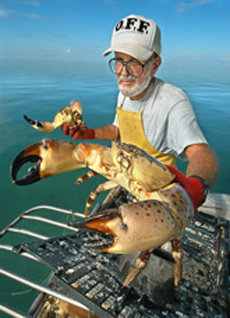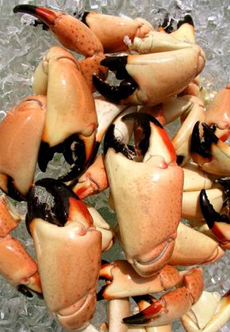TIP OF THE DAY: Stone Crab Claws
|
|
In the middle of hunting down the best Halloween candy, we overlooked a low calorie, protein packed, even more delicious event: the beginning of stone crab season, which runs from October 15th through May 15th.
The stone crab (Menippe mercenaria) is the only crab harvested commercially just for its claw meat. (Here are the different types of crabs.) It is named for its extremely hard shell. Because the majority of stone crabs sold in the U.S. come from Florida*, it is often referred to as Florida stone crabs. The claw meat is the best part of this crab: sweet and firm with a flavor and texture that is often described as a cross between its cousin, the Maryland blue crab, and lobster. If the crab claws look intimidating, that’s because they are. They are strong enough to crack open oyster shells and other crustaceans the stone crabs eat as they traverse the ocean floor. |
|
|
You can check with your fishmonger for availability, or head for the nearest quality steakhouse or seafood restaurant. We got the heads up from Del Frisco’s Double Eagle Steak House, which has locations in eight states, all dishing up stone crab claws (check to be sure they aren’t sold out!). If you’re cooking them at home, the rule of thumb is that approximately 2.5 pounds of cooked store crab claws yields one pound of meat. If you’re buying by size, there are medium 5-8 claws per pound, 3-5 large claws, 3 jumbo claws and 1-2 and colossal claws. |
||
|
WHY ARE ONLY THE CLAWS EATEN?
While the body and leg meat is edible: HOW TO SERVE STONE CRAB CLAWS The sweet stone crab meat needs little or no embellishment. It is typically served simply: chilled with drawn butter and lemon, or with cocktail sauce, Dijon sauce, mayonnaise or vinaigrette. |
 A live stone crab. Look at the size of those claws! Photo courtesy Euro USA. |
|
|
Thee meat can also be use in salads or crab rolls. But first you have to get it out of the shell! Whether enjoying stone crab at home or at a restaurant, prepare to work for your dinner. You’ll need some tools (mallet, nutcracker, pick) to get to the meat. That’s part of the fun. †The larger “crusher” claw is the one usually harvested. Either claw can regenerate three or four times over the lifetime of the crab; regeneration takes one to two years. In nature, stone crabs lose their limbs frequently when attacked by predators. Claws must be at least 2.75 inches long to be harvested and cannot be taken from egg-bearing females. Other crab species, lobster and other crustaceans can also regenerate claws, but their claw meat is not considered so spectacular as to be a food crop by itself.
|
||



